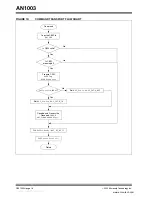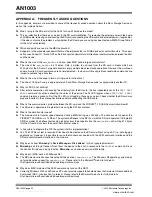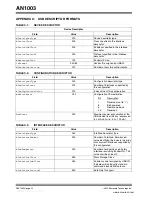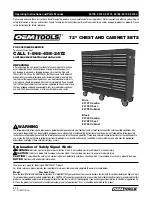
©
2005 Microchip Technology Inc.
DS01003A-page 9
AN1003
•
START/STOP
(Opcode 1Bh)
The
START/STOP
command requests that the
device server change the power condition of the log-
ical unit, or load, or eject the medium. This includes
specifying that the device server enable or disable
the direct access block device for medium access
operations by controlling power conditions and tim-
ers. The
POWER CONDITION
field (fifth byte, bit 7-4)
is used to specify that the logical unit be placed into
a power condition or to adjust a timer. If the value of
this field is not equal to 0h, the
START
(fifth byte,
bit 0) and
LOEJ
(Load Eject, fifth byte, bit 1) bits are
ignored. If the
POWER CONDITION
field is Active
(1h), Idle (2h) or Standby (3h), then the logical unit
shall transition to the specified power. If
POWER
CONDITION
= 0h (
START_VALID
), then the
START,
LOEJ = (0,0)
signifies that the logical unit shall
transition to the stopped power condition;
START,
LOEJ
= (0,1)
signifies the logical unit shall unload
the medium;
START, LOEJ = (1,0)
signifies that
the logical unit shall transition to the active power
condition. If
START, LOEJ = (1,1)
, then the
logical unit shall load the medium.
UNSUPPORTED COMMANDS
If the command opcode field in the
CBWCB
is not
supported, the
SENSE KEY
is set to Illegal Request,
indicating that there was an illegal parameter in the
CDB with
ASC
and
ACSQ
codes set corresponding to an
invalid command opcode.
MASS STORAGE DEVICE (MSD)
FIRMWARE
This firmware implements a USB-based Mass Storage
Device using an SD card. When plugged into the USB
port, the firmware enumerates the SD card as a remov-
able disk drive and allows the user to exercise all
standard features of a disk drive. The user can write,
read, edit and delete files on the MSD just like any other
removable disk media. This application also allows the
user to format the SD card in any of the following FAT file
formats: FAT16, FAT32 or NTFS (Windows drivers han-
dle the format, firmware is only required to implement
the SCSI commands). The firmware calculates the
capacity of the SD card based on the Card Specific Data
(CSD) register read from the SD card. This information
is conveyed to the PC host in response to the
READ
CAPACITY
command. The exact size of the disk can be
seen in the disk properties on the PC. Further details on
firmware and SCSI command implementation can be
found in
“SCSI Commands”
.
The project framework is organized under a single root
directory with each subdirectory containing files for
each category or class of source code. If the SD card is
not found, or not initialized, the 4 LEDs (D1, D2, D3 and
D4) on the demonstration board are turned on
permanently.
Using the PICtail™ Board for SD™ and
MMC Cards
First, connect the demonstration board to the MPLAB
®
ICD 2 and program the device. The following steps are
required to run the MSD application:
1.
Connect the PICtail™ Board for SD™ and MMC
Cards to the PICDEM FS USB Demonstration
Board as shown in Figure 1.
2.
Insert the SD card in the reader slot, making
sure that write-protect is disabled on the SD
card.
3.
Apply power to the demonstration board.
4.
Observe the LEDs (D1, D2, D3 and D4) on the
demonstration board. If all of the LEDs are ON,
this indicates an SD card initialization failure.
5.
If no errors have occurred, connect a USB cable
from the PC to the USB connector on the
demonstration board.
6.
Observe under
Control Panel > System >
Hardware > Device Manager
(for Windows XP
system) that
USB Mass Storage Device
gets
enumerated under
Universal Serial Bus
controllers
. Verify that the
Microchp Mass
Storage USB Device
is enumerated under
Disk
drive
and
Generic volume
is enumerated
under
Storage volumes,
as shown in Figure 5.
7.
Look for a removable drive under
My
Computer
.
8.
Use the removable drive icon to access the SD
card as a MSD.
9.
Before removing the USB cable from the demo
board, click the
“Safely Remove Hardware”
icon in the Windows task bar.
The four LEDs on the PICDEM FS USB Demonstration
Board have been implemented as follows:
1.
LED D1 turns ON after successfully responding
to the
INQUIRY
command.
2.
LED D2 toggles ON after each successful
TEST
UNIT READY
command execution.
3.
LED D3 blinks during read operation (turns ON
while a read from the SD card is taking place).
4.
LED D4 blinks during write operation (turns ON
while a write to the SD card is taking place).
深圳市英锐恩科技有限公司
www.enroo-tech.com











































